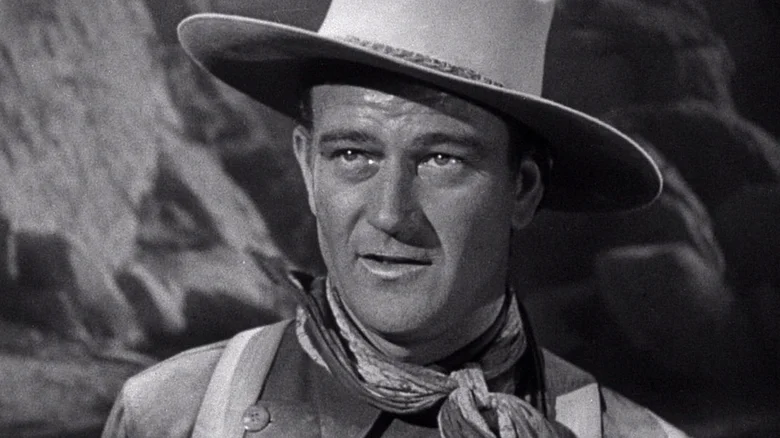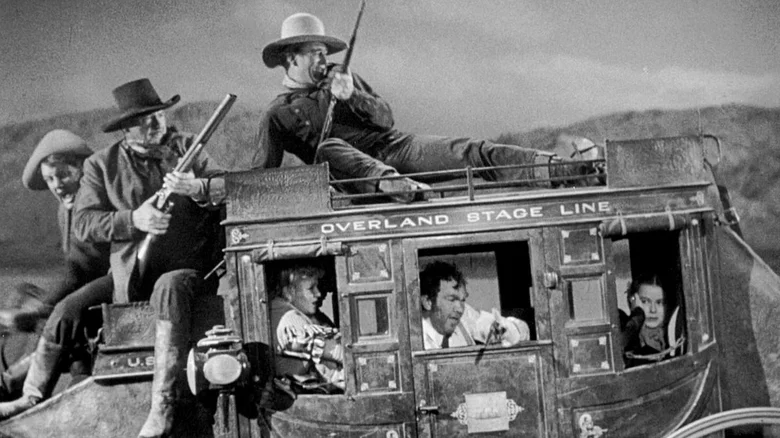It’s rare to see John Wayne back down in a standoff, but that’s exactly what happened when shooting one of his most revered films. By 1939, Wayne was no stranger to Westerns, though he wasn’t yet a household name. Wayne had already appeared in a string of uncredited roles in films by the legendary director John Ford in the late ’20s. So, when Ford made his triumphant return to the Western genre with “Stagecoach” he tapped Wayne for the lead character, Ringo Kid.
Casting Wayne was the first of a lengthy series of battles with United Artists. The studio wanted a big name for the film, but Ford had a feeling about the charismatic 32 year old and insisted on him for the role. Ford introduces viewers to Wayne in dramatic fashion, with a zoom-in on a rifle-wielding Ringo Kid in front of a gorgeous landscape of Monument Valley plateaus (where many of Ford’s Westerns were shot). When Marshall Curley says, “Hello, Kid” to Ringo, he might as well have been speaking collectively for U.S. film audiences. We called it Wayne’s best movie moment ever.
The fight to secure Wayne for the role of Ringo Kid wasn’t the last for Ford or Wayne in the production of “Stagecoach.” Behind the scenes, a standoff between Wayne and the studio took place that rivaled a climax from one of his films. Only this time, The Duke didn’t come out on top.
Wayne was doing nearly all of the stunts

Although not considered a single-location film (movies with narratives that take place entirely in one location), much of “Stagecoach” takes place inside the cramped confines of the titular horse-drawn carriage. It’s there that Ford introduces us to a collection of flawed characters traveling from Arizona to New Mexico. To get there, they must pass through what was labeled dangerous Apache country (in an unfortunate but common classical Hollywood stereotype of Native Americans as bloodthirsty savages).
The stagecoach group includes a prostitute, a drunken doctor, a crooked banker, and a whiskey salesman. Along the way, they pick up Ringo Kid, who recently escaped from prison to avenge the murder of his father and brother. When they lose their cavalry escort, Ringo leads the group to their destination and exacts revenge against the men that killed his family. That’s where the typical Western shootouts and action sequences ensue.
In the John Wayne biography “Shooting Star,” author Maurice Zolotow explains that a battle raged behind the scenes over Wayne’s stunt work in the film. Zolotow writes:
“Ford permitted Wayne to do many of his own stunts, though he took the risk of Wayne breaking a leg and holding up production. He did it against the opposition of [United Artists producer Walter] Wanger because he knew it would give Duke a better sense of reality, though he insisted on [stuntman Yakima] Canutt doing the most hazardous stunts.”
But Wanger pushed back, setting up a real-life standoff that was befitting of a dusty Old West thoroughfare.
‘I’m not an actor … I’m a stuntman’

“Stagecoach” could be considered as much a drama as it is a traditional Western. Even so, there was plenty of action to keep Wayne and stunt coordinator Yakima Canutt busy. But the sight of their budding star jumping onto roofs made United Artists nervous. According to Zolotow:
“Visiting the set one morning, out in Monument Valley, producer [Walter] Wanger was shocked to see Duke playing a scene in which he leaped out of the stagecoach and climbed on the roof. ‘Jack,’ he said to the director, ‘I want you to get Wayne to stop stunting. He is too valuable to lose.'”
Ford told Wanger that he’d have to tell Wayne himself. The veteran producer didn’t back down. “Duke, you are going to be an outstanding star. I do not want you to do any more of these stunts,” Wanger told Wayne. “My God, if you broke a leg or an arm it would hold up the picture for weeks.”
The young actor, starring in his biggest film to date, boldly responded to the producer as only The Duke could. “Now, Mr. Wanger, there is no need for you to worry,” Wayne answered, as if in character. “I can handle myself. I been ridin’ horses and stuntin’ for years. I’m not an actor. I don’t act. I react. I’m just a stuntman.”
Despite Wayne’s protest, Wanger persisted. Ford eventually stepped in so they wouldn’t lose production time and convinced Wayne to let his stunt double do most of the work. It was a rare defeat but ultimately a win for The Duke. The film cemented his status as a Western icon and is included on the U.S. Library of Congress National Film Registry for its cultural significance.
